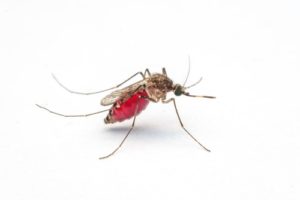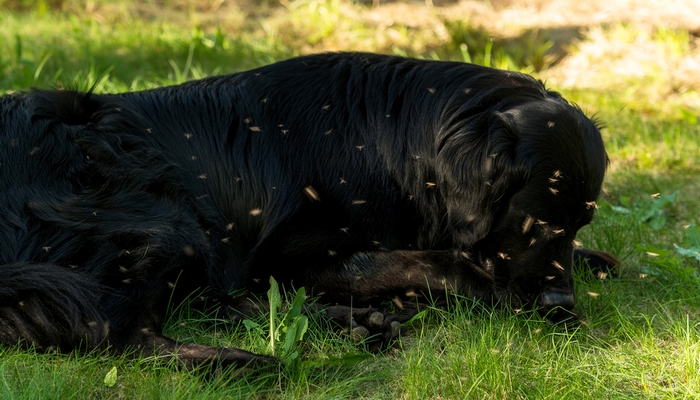Heartworm. It’s exactly what it sounds like: parasitic worms that feed on your dog’s heart. They’re disgusting, deadly, found all over the world and are spread by mosquitoes. I personally received a very intimate introduction to heartworm in dogs when I adopted my pup, Skittles, a heartworm-positive survivor of Hurricane Katrina, which made me research this area much closer.
 Heartworms are dog-loving parasites that can also infect people. Baby heartworms hitch a ride in the mouths of mosquitoes. When an infected mosquito bites your dog, the baby worms are injected into his bloodstream. They grow, latch onto organs to feed, have more babies that are sucked up by mosquitoes and then spread to more dogs.
Heartworms are dog-loving parasites that can also infect people. Baby heartworms hitch a ride in the mouths of mosquitoes. When an infected mosquito bites your dog, the baby worms are injected into his bloodstream. They grow, latch onto organs to feed, have more babies that are sucked up by mosquitoes and then spread to more dogs.
Skittles’ situation wasn’t rare. In the United States it is estimated that 1 in 76 dogs have heartworm, nearly 50 percent of Katrina rescues were infected with heartworms. After adopting Skittles, I became obsessed with understanding how so many dogs ended up so sick.
Luckily for me, a group of researchers also wanted to understand the ideal conditions for heartworm disease. They calculated what kinds of patterns or changes might increase a dog’s chances of getting heartworm.
The researchers found ten factors that, when combined, make an ideal environment for heartworm to thrive. Their hope was that knowing those ten factors could help create better “spatial risk maps,” also called predictions for where heartworm outbreaks would be the worst.
Today, I'm going to explore this research and tell you all about the ten factors that have been proven to make an ideal environment for heartworm to thrive.
- RECOMMENDED: Heartworm Prevention in Dogs
Causes of Heartworm in Dogs
Each one of the factors found by the researchers was like an ingredient in a cake recipe. With only a few of the ingredients, it’s hard to make a proper cake. But, if you add every ingredient from the recipe in the proper amounts and bake it for the right time, you get a perfect cake. Except, in this case, cake is heartworm disease.
Those heartworm “ingredients” fall into three broad groups:
- vector factors – conditions that make it easy for mosquitoes to thrive
- parasite factors – how easy it is for heartworms to grow and multiply
- host factors – how well-protected the dog population is from heartworm
Vector Factor – Mosquitoes
The #1 spot on the doctor’s ingredient list belongs to mosquitoes. Called the most lethal animal on the planet, mosquitoes are the vectors that fuel the heartworm infection engine. Think of mosquitoes as the cake pan into which all the other heartworm ingredients are dumped.
 Without that pan, there’s no cake. Likewise, without mosquitoes, there would be no heartworm in dogs. The researchers knew that by pinpointing where mosquitoes were most active, they’d already be well on their way to predicting heartworm outbreaks.
Without that pan, there’s no cake. Likewise, without mosquitoes, there would be no heartworm in dogs. The researchers knew that by pinpointing where mosquitoes were most active, they’d already be well on their way to predicting heartworm outbreaks.
Unluckily for us, there are at least nine species of mosquitoes that are GREAT at carrying heartworm and 60 that are decent at it. Those nine super skeeters range all over the country (PDF), which means every single dog is at risk.
Yes, even Alaskan dogs.
It makes sense, then, that other important ingredients are what affect mosquitoes’ ability to survive, breed and bite. Where I’m from, I set my “it’s summertime” alarm by how many mosquito bites I get when I go outside. That’s because mosquitoes are more active in summer. They need a warm climate and standing water to make babies.
The researchers discovered that by tracking changes in seasons and rainfall across mosquito territory, they could predict a baby boom. Thus, they could guess when there would be more bugs to carry heartworm.
RELATED: Can Humans Get Worms From Dogs?
The “vector factor” ingredient list conveniently solves the first piece of Skittle’s and other Katrina rescue dog’s high heartworm disease rate puzzle. The South, with more rain and a warmer climate, breeds more mosquitoes.
after Katrina, when there was standing water in the city for months and temperatures well over 80 degrees, the bugs threw a block party.
In order to get heartworm in dogs, you need mosquitoes. We know that. But, you also need heartworms. The researcher’s next ingredient had to do with what kinds of things encourage heartworms to survive and reproduce – the “parasite factors.”
Parasite Factors – Heartworms
Heartworms also have ideal environmental conditions for growing and breeding, but their environment is inside mosquitoes and eventually your dog. Like other kinds of parasites, heartworms have different developmental stages.
You can think of them as being a newborn versus a small child versus an adolescent versus adult. Newborn heartworms (called microfilaria) are what live in mosquitoes. If the mosquito is doing well, hanging out at a nice temperature and feeding, the newborn heartworm is able to grow into an adolescent.
What’s really crazy is that in order to grow, heartworms need their mosquito host’s environment to be at least 57 degrees. If the temperature dips below that, the heartworms can pause their development and restart once it gets warm again. If the mosquitoes can stand it, so can the worms.
On average, it takes about four months for that newborn heartworm to become an adolescent. Just like human teenagers, adolescent heartworms are awful! It’s in this stage they become infectious and can jump from the mosquito to your dog.
By knowing heartworm growth patterns, the researchers could use the number of days with good heartworm growing conditions to forecast initial infections.
I say “initial” because the test to detect heartworm in dogs isn’t effective until the worms reach their adult stage. That doesn’t happen for another six or nine months after they’ve entered your dog.
For example, let’s say a dog shows up at a vet clinic in November and has a positive heartworm test. We know that at the latest, a heartworm-carrying mosquito bit the dog in May. But, it could have been as early as February. It fact, it could have happened in the previous year if the temperature wasn’t ideal and the heartworms took longer than average to develop.
Why does that matter?
For the researchers, that delay between infection and diagnosis was really, really important to take into account. For any diagnosed case of heartworm in dogs, doctors had to consider what conditions had been present seven months to two years prior. This made the whole risk prediction process a lot trickier.
In order to be accurate, a lot of data over a longer period of time have to be crunched.
For the Katrina pups, that lag between infection, testing and treatment probably would have happened anyway. City services, like vet clinics and shelters, were so nonexistent that it took months and months to get a lot of the dogs off the streets to undergo testing.
Skittles had a particularly rough go of it. The vets thought she’d been a puppy when the storm hit, got heartworm almost immediately and then wasn’t taken to a shelter for a long time. By the time I adopted her, she’d had heartworm for a while.
This leads us into the third group of ingredients—“host factors,” or how well protected the dog population is against heartworm.
RECOMMENDED: 15 Cheap Ways To Prevent Most Common Health Issues In Dogs
Host Factors – Protection Against Heartworm in Dogs
If you have a dog, you’re no doubt familiar with heartworm preventatives – at least I hope you’re familiar! If you aren’t, I’m so glad you’re reading this!
Curing heartworm in dogs is expensive and dangerous. I’ll tell you about Skittles’ treatment in a bit to help you better understand. Preventatives are very gentle and effective, so there’s really no reason to skip them.
Sadly, when the researchers looked at their data, it appeared that only about 75 percent of dog owners had their dog on heartworm preventative. That is a big problem for two reasons. First of all, dogs die from heartworm disease. Also, dogs infected with heartworm can spread it to other dogs.
Once those adult heartworms take up residence in your dog’s pulmonary arteries and start feeding, they grow to an absolutely revolting 11 inches long. At this point. they can churn out newborns that are sucked up by mosquitoes.
 Knowing that some dogs are unprotected is all well and good, but in order to paint a clear picture of high-risk areas, the researchers also wanted to know why people skipped prevention.
Knowing that some dogs are unprotected is all well and good, but in order to paint a clear picture of high-risk areas, the researchers also wanted to know why people skipped prevention.
They found that owners who didn’t have a lot of money were less likely to put their dogs on meds. Interestingly, though, super rich dog owners were also less likely to have their dogs on preventatives!
Once more, when looking at Skittles and other Southern dogs’ lives, their findings were unsurprising. Mississippi is the poorest state in the country, with Louisiana and Alabama not far behind. The owners who are least likely to be able to afford preventatives for heartworm in dogs also live in the places with the best conditions for the parasite to spread.
What This Means for Dog Owners
These researchers showed me that there were four massive strikes against these Katrina canine survivors:
- they lived in a mosquito-rich part of the world
- there were good conditions for heartworm to grow
- there were a lot of owners who couldn’t afford heartworm preventatives
- a historic storm separated animals from caretakers for months or years
Looking at all that, I’m actually surprised that only 50 percent of them were positive for heartworm in dogs.
I’m sorry if you thought that was the end of the bad news, because it’s not.
Not only can dogs get heartworm, but cats, seals, ferrets, red pandas and coyotes can too. So, even if hypothetically you could get 100 percent of dog owners to put their pooch on preventatives, there would STILL be mosquitoes carrying heartworm thanks to bug-bitten dog-relatives roaming in the wild.
As if that weren’t bad enough, these researchers pointed out that there are a lot of other important factors to look at. These factors include how often heartworm is spread after only one bite, how far mosquitoes can fly and how big of a developmental pause heartworms can survive.
Unfortunately, there weren’t enough answers to those questions to plug them in to their predictions.
Furthermore, while the researchers had chosen ingredients that were generally easy to find everywhere (like average rainfall—everyone keeps track of that), for some conditions, the information could be a bit wonky.
Take testing for heartworm in dogs, for instance. Not everyone gets their dog tested for heartworm, and some vet clinics don’t report the total number of tests they do – just the number of positive tests. Across an entire state, each different town might have a slightly different way of testing and recording information about heartworm.
Fortunately, science has an answer to wonky information. When you have a lot of data that isn’t quite the same, you can stack up the common info and create a plug for the missing pieces with math.
The researchers used a mathematical equivalent to fill any data gaps within their ingredient list to calculate how likely a place was to have a positive test for heartworm in dogs. If you want to see the exact equations, look at the ‘Methods' section of their paper linked at the beginning of this article.
RELATED: The Best Dog DeWormer Review
Now that they’ve created these equations, it really is possible to build a map of places in the U.S. where there’s more likelihood of heartworm disease. As long as you can track down the items on their list (Types of mosquitoes? Climate? Humidity and standing water? Days over 57 degrees? Dogs on preventative? Lots of feral animals?) you can mix it all together and see what comes out.
Maybe if we’d had this tool earlier, fewer Katrina pups would have gotten ill and died. Now, though, at least vets can use the researcher’s information to find higher-risk areas and teach owners how important year-round preventatives are, or to encourage certain towns to spray for mosquitoes more often.
You know what good old Ben Franklin said: “An ounce of prevention is worth a pound of cure,” which is really true when it comes to treating heartworm. In Skittles’s case, she was too far gone to benefit from preventatives, so she had to use the cure treatment.
Treatment for Heartworm in Dogs
Once a dog has an established case of heartworm, there’s only one way to evict the adults – with an arsenic compound. In addition to being poison the drug (known as melarsomine) is also very expensive.
Skittles’s three-month treatment cost north of $700, which doesn’t include the vet visit payments and hospital stays. Because the organization that I got her from is awesome, they helped me with the fees and the vet even gave me a discount.
But $700 will literally buy you 10 years' worth of heartworm prevention medication.
The cure meds aren’t ‘one-and-done' either. There are multiple injections. Once the worms begin to die, they break into fragments. Usually, a dog’s body is able to slowly process the worm bits out, but if pups get overexcited or exercise too much, worm chunks can snap off and lodge in their lungs, causing an embolism that will kill them.
 You know what dogs dislike? Chilling all day in crates and not moving around much. Even though it was for her own good and I knew it would soon be over, my heart broke seeing Skittles go from curled up and despondent in the shelter to curled up and despondent in the posh kennel I got her.
You know what dogs dislike? Chilling all day in crates and not moving around much. Even though it was for her own good and I knew it would soon be over, my heart broke seeing Skittles go from curled up and despondent in the shelter to curled up and despondent in the posh kennel I got her.
Luckily for Skittles and me, five months later, her tests came back clean and she was free from jail. We celebrated by getting doggy Fro-Y and I topped her cone with a beef-flavored heartworm preventative chew.
Now, every thirty days like clockwork, I give Skittles her preventative. Even though we moved away from Louisiana to a place not considered high risk, she still gets her monthly dose. As I watch her chew, I remember that the researcher’s lists of ingredients only had one item over which I had any control – keeping my dog from being a host by protecting her.
If you own a dog and live in a warm climate with lots of rainfall or a lot of vegetation, make sure your dog is always on a heartworm preventative, and if they’re not or you’ve missed doses, get them tested right away. If you live in a cold, dry climate, you should still put your dog on heartworm preventatives.
Follow the dosing guide included with the medication, but generally each dose should be given no more than 30 days apart.
If you’re thinking about adopting a dog, consider one that’s heartworm positive. Heartworms are treatable, curable and don’t have to be a death sentence. Many vet clinics and shelters will waive adoption fees and assist with heartworm treatment costs.
If your true doggy love has a few extra internal squatters, forge on! There’s something special about the bond you and your dog will form after you’re finished vanquishing the parasites.
READ NEXT: Ear Mites in Dogs – Symptoms, Natural and Veterinary Treatments, Prevention
















